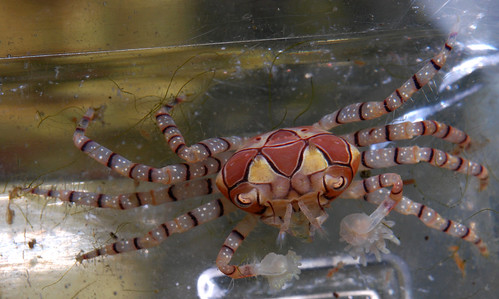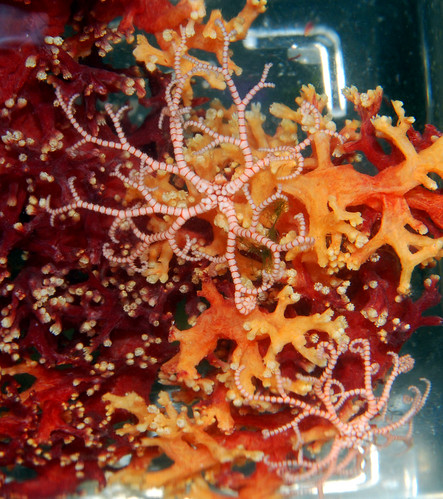

I'm doing a little experiment to see if it's true that pom pom crabs share their anemones with one another, then frag them to make more. I think it's more likely that they steal anemones from each other. When a pom pom crab molts, it puts down its anemones for a short time until it can shed its old exoskeleton and pick them back up again. Perhaps that is when they are most vulnerable to anemone theft! Unless I see it happening, I may never know. But hopefully my older pom pom crab acquires some new anemones somehow, because she lost hers a few months ago and has been carrying around sponges instead. It's kind of sad and pathetic.

Word has gotten around that I like Crinoids and other non-photosynthetic animals, so I was given some basket stars last week. Thanks, Joe! You're awesome!

I have no idea what species these basket stars are. If you click on the photo to enlarge it, you can see that they are pinkish with red-orange stripes all over them. If I had to name them, I'd call them "candy-striped basket stars." They are only about the size of a nickel when they spread out. These are the smallest basket stars I've ever seen, hopefully they'll be easier to feed as a result. They came on this gorgeous non-photosynthetic orange and red soft coral, which I also couldn't ID. It reminds me of corals related to Dendronepthea sp. and Stereonephthya sp. Anyone know what this is? It wasn't attached to a rock, so I rubber-banded it to a heavy coral mariculture plug. I'm going to pin it tomorrow with a long stainless steel frag pin. The stars haven't strayed from the coral yet.
 The other basket starfish I got this week is a Caribbean basket starfish, Astrophyton muricatum, similar to the one pictured. I had that one come in as a hitchhiker on a Gorgonian order a couple years ago, and it didn't last long. That is how I learned that basket starfish can crawl inside return pumps and get destroyed by the impeller. Since then, all my pumps have been covered with ugly mesh bags. The one I got this week is about the size of a large man's hand when it is stretched out. This species grows to three feet in diameter in the wild.
The other basket starfish I got this week is a Caribbean basket starfish, Astrophyton muricatum, similar to the one pictured. I had that one come in as a hitchhiker on a Gorgonian order a couple years ago, and it didn't last long. That is how I learned that basket starfish can crawl inside return pumps and get destroyed by the impeller. Since then, all my pumps have been covered with ugly mesh bags. The one I got this week is about the size of a large man's hand when it is stretched out. This species grows to three feet in diameter in the wild.I hope to do better with this basket star than with my last one. Like most other non-photosynthetic marine creatures, the majority of the basket star's diet will have to come from my aquarium's refugium and sand bed. In the wild Caribbean basket stars prefer to eat pelagic copepods and other small zooplankton, so Cyclop-eeze, Cyclops, and rotifers are an ideal supplemental diet for a small to medium-sized basket star.
Here's an older article about basket stars on reefs.org http://www.reefs.org/library/article/r_toonen17.html

Do you have any updates on your basket stars?
ReplyDelete